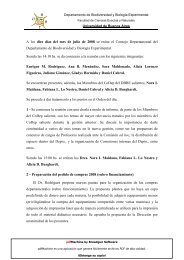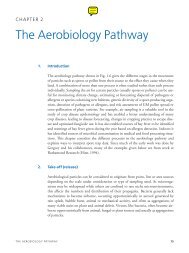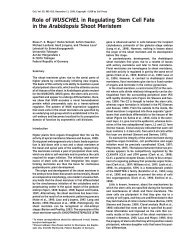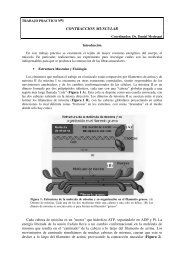Osmoregulation in a nectar-feeding insect, the carpenter bee ...
Osmoregulation in a nectar-feeding insect, the carpenter bee ...
Osmoregulation in a nectar-feeding insect, the carpenter bee ...
You also want an ePaper? Increase the reach of your titles
YUMPU automatically turns print PDFs into web optimized ePapers that Google loves.
Physiological Entomology (1990) 15,433-440<br />
<strong>Osmoregulation</strong> <strong>in</strong> a <strong>nectar</strong>-feed<strong>in</strong>g <strong>in</strong>sect, <strong>the</strong> <strong>carpenter</strong> <strong>bee</strong><br />
Xylocopa capitata: water excess and ion conservation<br />
SUSAN W . N I C 0 LS ON<br />
South Africa<br />
Introduction<br />
Department of Zoology, University of Cape Town,<br />
Abstract. The liquid diet and high metabolic water production dur<strong>in</strong>g<br />
flight <strong>in</strong> <strong>the</strong> <strong>carpenter</strong> <strong>bee</strong> Xylocopa capitata Smith 1854 (Hymenoptera,<br />
Anthophoridae) causes a water excess, and this is exacerbated by a low<br />
dietary <strong>in</strong>take of ions. The <strong>nectar</strong> and pollen of <strong>the</strong> preferred food-<br />
plants, Virgilia divaricata Adamson and Podalyria cafyptrata Willd.,<br />
and o<strong>the</strong>r Fabaceae had low levels of sodium. Analyses of <strong>the</strong> <strong>bee</strong>s and<br />
<strong>the</strong>ir body fluids showed that <strong>the</strong> <strong>bee</strong>s have an exceptionally low Na<br />
content, and Na homeostasis seems to depend on recycl<strong>in</strong>g almost all<br />
Na which enters <strong>the</strong> rectum. The copious dilute ur<strong>in</strong>e (137 mOsm) had<br />
Na and K concentrations of only 3.4 and 7.0 mM, respectively. Isolated<br />
preparations of Xylocopa Malpighian tubules secreted a fluid with a K<br />
concentration 10 times that of <strong>the</strong> haemolymph. This means that<br />
recycl<strong>in</strong>g of K is as important as that of Na, and <strong>the</strong> bulk of K resorption<br />
probably occurs passively <strong>in</strong> <strong>the</strong> ileum. This study is <strong>the</strong> first to exam<strong>in</strong>e<br />
hymenopteran Malpighian tubules. Their stimulation by CAMP is <strong>in</strong>-<br />
dicative of <strong>the</strong> presence of a diuretic hormone <strong>in</strong> Xylocopa.<br />
Key words. Water and ionic balance, sodium, potassium, <strong>nectar</strong>,<br />
pollen, Malpighian tubules, h<strong>in</strong>dgut, Xylocopa.<br />
Because <strong>nectar</strong> is primarily a sugar solution and<br />
most poll<strong>in</strong>ators have high energy demands,<br />
much emphasis has <strong>bee</strong>n placed on <strong>the</strong> energ-<br />
etics of <strong>the</strong> relationship between plants and<br />
<strong>the</strong>ir poll<strong>in</strong>ators. Only very recently has any<br />
attention <strong>bee</strong>n paid to <strong>the</strong> water component of<br />
<strong>nectar</strong> and <strong>the</strong> water balance of poll<strong>in</strong>ators.<br />
Where <strong>in</strong>sects are concerned, this work has<br />
<strong>bee</strong>n conf<strong>in</strong>ed to various species of <strong>bee</strong>. In <strong>the</strong><br />
large <strong>carpenter</strong> <strong>bee</strong> Xylocopa capitata Smith<br />
1854 (Hymenoptera, Anthophoridae), Nicolson<br />
& Louw (1982) found that metabolic water<br />
production dur<strong>in</strong>g flight was so high that <strong>the</strong><br />
<strong>bee</strong>s might acquire excess water from <strong>the</strong>ir<br />
Correspondence: Dr Susan W. Nicolson, Department<br />
of Zoology, University of Cape TOWR, Rondcbosch<br />
7700. South Africa.<br />
flowers. This was confirmed for male bumble-<br />
<strong>bee</strong>s, Bornbus lucorurn, by Bertsch (1984).<br />
The smaller honey<strong>bee</strong> produces less metabolic<br />
water, and <strong>in</strong>curs a water deficit <strong>in</strong> a dry climate.<br />
It is <strong>the</strong>n obliged to collect free water (Louw &<br />
Hadley, 1985). Both honey<strong>bee</strong>s and <strong>the</strong> solitary<br />
mason <strong>bee</strong> Chalicodorna sicula have <strong>bee</strong>n shown<br />
to compromise between two conflict<strong>in</strong>g needs,<br />
for sugar and for water (Ohguchi & Aoki, 1983;<br />
Willmer, 1986). Fur<strong>the</strong>r work on Xylocopa has<br />
demonstrated that two species forag<strong>in</strong>g at <strong>the</strong><br />
same plant <strong>in</strong> sou<strong>the</strong>rn Israel have different<br />
water requirements, <strong>the</strong> smaller <strong>bee</strong> be<strong>in</strong>g more<br />
dependent on <strong>the</strong> water component of <strong>the</strong> <strong>nectar</strong><br />
(Willmer, 1988).<br />
The osmoregulatory problems of animals<br />
<strong>in</strong>volve salts as well as water. Among <strong>nectar</strong>-<br />
ivores, humm<strong>in</strong>gbirds have received some at-<br />
tention <strong>in</strong> this respect (Calder & Hiebert, 1983).<br />
However, <strong>the</strong>re has to date <strong>bee</strong>n no <strong>in</strong>vestigation<br />
433
434 Susan W. Nicolson<br />
of <strong>the</strong> ionic balance of a <strong>nectar</strong>-feed<strong>in</strong>g <strong>in</strong>sect,<br />
o<strong>the</strong>r than <strong>the</strong> work of Pivnick & McNeil(l987)<br />
on <strong>the</strong> skipper butterfly Thymelicus, <strong>in</strong> which<br />
sodium ions play an unusual role <strong>in</strong> reproduction.<br />
That Xylocopa capitata does not experience a<br />
water shortage was confirmed by analyses of<br />
<strong>nectar</strong> and body fluids, which showed that <strong>the</strong><br />
<strong>bee</strong>s produce a very dilute ur<strong>in</strong>e and <strong>in</strong> fact may<br />
have problems of ion conservation (Nicolson &<br />
Louw, 1982). The present study exam<strong>in</strong>es ion<br />
balance <strong>in</strong> X.capitata <strong>in</strong> more detail, by look<strong>in</strong>g<br />
at dietary <strong>in</strong>take, ion levels <strong>in</strong> <strong>the</strong> <strong>bee</strong>s and <strong>the</strong>ir<br />
body fluids, and <strong>the</strong> role of <strong>the</strong> Malpighian<br />
tubules.<br />
Materials and Methods<br />
Bees and flowers. In <strong>the</strong> Cape Town area <strong>the</strong><br />
forag<strong>in</strong>g of X.capitata is largely conf<strong>in</strong>ed to two<br />
genera of <strong>the</strong> Fabaceae. The food plant <strong>in</strong> early<br />
spr<strong>in</strong>g, and an important site for territorial<br />
males, is Podalyria calyptrata Willd., which is<br />
replaced by Virgilia divaricata Adamson dur<strong>in</strong>g<br />
<strong>the</strong> ma<strong>in</strong> breed<strong>in</strong>g season of X.capitata. Later<br />
<strong>in</strong> <strong>the</strong> summer <strong>the</strong> old females, and a few newly<br />
emerged <strong>bee</strong>s, are found on <strong>the</strong> flowers of<br />
ano<strong>the</strong>r species of Virgilia, V.oroboides (Berg.)<br />
Salter. Bees and flowers were collected between<br />
September 1988 and January 1989, <strong>in</strong> Newlands<br />
Forest and at Kirstenbosch Botanic Gardens,<br />
both study sites be<strong>in</strong>g with<strong>in</strong> a few m<strong>in</strong>utes by<br />
car from <strong>the</strong> University of Cape Town.<br />
As far as possible, this study was conf<strong>in</strong>ed to<br />
males of X.capitata, <strong>in</strong> order to conserve <strong>the</strong><br />
breed<strong>in</strong>g population, and because pollen is a<br />
m<strong>in</strong>or component of <strong>the</strong> diet of <strong>the</strong> males.<br />
However, males become active earlier <strong>in</strong> <strong>the</strong><br />
spr<strong>in</strong>g and apparently have a shorter life-span<br />
than females. It was necessary <strong>the</strong>refore to use<br />
older females for some analyses <strong>in</strong> late summer.<br />
Although females were previously found to be<br />
about 25% heavier than males (Nicolson &<br />
Louw, 1982), no difference <strong>in</strong> body mass be-<br />
tween <strong>the</strong> sexes was found <strong>in</strong> <strong>the</strong> <strong>bee</strong>s sampled<br />
<strong>in</strong> <strong>the</strong> present study.<br />
Diet. The <strong>nectar</strong> and pollen of V.divaricata<br />
have previously <strong>bee</strong>n analysed <strong>in</strong> some detail<br />
(Nicolson & Louw, 1982; Louw & Nicolson,<br />
1983). For Podalyria I exam<strong>in</strong>ed <strong>the</strong> follow<strong>in</strong>g<br />
attributes of <strong>the</strong> <strong>nectar</strong> and pollen, us<strong>in</strong>g <strong>the</strong><br />
methods already described for Virgilia: <strong>nectar</strong><br />
volume, sugar concentration, and sodium and<br />
potassium concentrations, as well as pollen<br />
weight, water content and Na and K concen-<br />
trations. Nectar of two o<strong>the</strong>r plants was also<br />
analysed: Wisteria s<strong>in</strong>ensis and Rob<strong>in</strong>ia pseudo-<br />
acacia, both <strong>in</strong>troduced members of <strong>the</strong><br />
Fabaceae which are attractive to <strong>carpenter</strong> <strong>bee</strong>s<br />
dur<strong>in</strong>g <strong>the</strong>ir brief flower<strong>in</strong>g periods. All <strong>nectar</strong><br />
samples were collected between 10.00 and 11.00<br />
hours, on days when X.capitata was active.<br />
Analyses of body fluids and <strong>bee</strong>s. Freshly<br />
collected <strong>bee</strong>s frequently produced ur<strong>in</strong>e when<br />
disturbed. O<strong>the</strong>r body fluids (haemolymph,<br />
crop contents, midgut fluid and rectal fluid)<br />
were collected by dissect<strong>in</strong>g cold-anaes<strong>the</strong>tized<br />
<strong>bee</strong>s and sampl<strong>in</strong>g with calibrated micropipettes<br />
(Drummond Scientific Co.). Osmotic con-<br />
centrations were measured us<strong>in</strong>g a Wescor<br />
(Model 5 100B) vapour pressure osmometer,<br />
and Na and K concentrations by means of<br />
standard flame photometric techniques (Instru-<br />
mentation Laboratory, Model IL 243).<br />
Water contents of <strong>the</strong> <strong>bee</strong>s were obta<strong>in</strong>ed by<br />
dry<strong>in</strong>g at 60°C for 48 h. If unusually large<br />
volumes of fluid were present <strong>in</strong> crop or rectum,<br />
<strong>the</strong>se were first removed. Cation concentrations<br />
were <strong>the</strong>n determ<strong>in</strong>ed on <strong>the</strong> dried samples by<br />
ash<strong>in</strong>g at 500°C for 4 h, digest<strong>in</strong>g <strong>in</strong> concentrated<br />
nitric acid and dilut<strong>in</strong>g for ion estimations by<br />
flame photometry.<br />
Determ<strong>in</strong>ation of haemolyrnph volume.<br />
Cold-anaes<strong>the</strong>tized <strong>carpenter</strong> <strong>bee</strong>s were<br />
weighed and <strong>in</strong>jected with 5 p1 of a solution<br />
of 'H-<strong>in</strong>ul<strong>in</strong> (0.78 pCi per <strong>bee</strong>). Bees were<br />
<strong>in</strong>jected laterally between <strong>the</strong> fourth and fifth<br />
abdom<strong>in</strong>al sclerites to m<strong>in</strong>imize <strong>the</strong> risk of punc-<br />
tur<strong>in</strong>g <strong>the</strong> crop. No bleed<strong>in</strong>g occurred.<br />
The diluted 'H-<strong>in</strong>ul<strong>in</strong> was sampled 5 m<strong>in</strong><br />
after <strong>in</strong>jection. An <strong>in</strong>cision was made <strong>in</strong> <strong>the</strong><br />
second abdom<strong>in</strong>al segment and 5 pl of haemo-<br />
lymph drawn <strong>in</strong>to a calibrated micropipette.<br />
This was transferred to 1 ml of distilled water<br />
<strong>in</strong> a sc<strong>in</strong>tillation vial before mix<strong>in</strong>g with 10 ml<br />
Insta-gel (Packard Instrument Co.) and<br />
count<strong>in</strong>g <strong>in</strong> a Packard Tri-Carb 460C liquid<br />
sc<strong>in</strong>tillation counter.<br />
Malpighian tubules. The Malpighian tubules<br />
of X.capitata were studied as isolated prep-<br />
arations under liquid paraff<strong>in</strong>, with each tubule<br />
placed <strong>in</strong> a drop of bath<strong>in</strong>g medium and its<br />
open proximal end wrapped around a f<strong>in</strong>e p<strong>in</strong>.<br />
The bath<strong>in</strong>g medium surround<strong>in</strong>g <strong>the</strong> isolated<br />
tubules conta<strong>in</strong>ed (<strong>in</strong> mM): NaCl 42, KCI 17,<br />
MgC12 5, CaC12 2, NaHC03 6, NaH2P04 4,
glyc<strong>in</strong>e 10, prol<strong>in</strong>e 10, ser<strong>in</strong>e 10, histid<strong>in</strong>e 10,<br />
glutam<strong>in</strong>e 10 and glucose 285. Very little is<br />
known about <strong>the</strong> composition of <strong>bee</strong> haemo-<br />
lymph. The Na and K concentrations, and total<br />
osmolarity , were based on earlier measurements<br />
on <strong>the</strong> haemolymph of X.capitata (Nicolson &<br />
Louw, 1982). Apparently <strong>in</strong>organic ions con-<br />
tribute little to <strong>the</strong> total osmolarity, hence <strong>the</strong><br />
high concentration of glucose <strong>in</strong>cluded <strong>in</strong> <strong>the</strong><br />
bath<strong>in</strong>g medium. Its measured osmolarity was<br />
475 mOsm, less than <strong>the</strong> mean of 544 mOsm<br />
reported by Nicolson & Louw (1982) but well<br />
with<strong>in</strong> <strong>the</strong> normal range of haemolymph osmo-<br />
lari ty of X. capitata.<br />
Secretion rates of X. capitata tubules were<br />
measured under control conditions and <strong>in</strong> <strong>the</strong><br />
presence of 1 mM adenos<strong>in</strong>e 3’3’ cyclic mono-<br />
phosphoric acid (CAMP, Na salt, Sigma Chemi-<br />
cal Co.). CAMP mimics <strong>the</strong> action of <strong>in</strong>sect<br />
diuretic hormones on Malpighian tubbles. The<br />
isolated tubules were ma<strong>in</strong>ta<strong>in</strong>ed at a constant<br />
temperature of 25°C. Secretion rates were ob-<br />
ta<strong>in</strong>ed by measur<strong>in</strong>g <strong>the</strong> diameters of <strong>the</strong> se-<br />
creted droplets with an eyepiece graticule,<br />
and calculat<strong>in</strong>g <strong>the</strong>ir volumes. The same drop-<br />
lets were <strong>the</strong>n removed with siliconed micro-<br />
pipettes for determ<strong>in</strong>ations of <strong>the</strong>ir Na and K<br />
concentrations.<br />
All results are presented as means +SE, with<br />
n <strong>in</strong> paren<strong>the</strong>ses. Independent sample t-tests<br />
were used to assess <strong>the</strong> significance of differ-<br />
ences between means, with P values of
436 Susan W. Nicolson<br />
Table 2. Nectar composition of Wisteria s<strong>in</strong>ensis and Rob<strong>in</strong>ia pseudoacacia.<br />
Wisteria Rob<strong>in</strong>ia<br />
Volume (pI/flower) 1.4020.14 (10) 0.5720.09 (10)<br />
Sugar concentration (g/100 ml) 39.7k2.3 (10) 85.6a7.2 (10)<br />
Total sugar (mg) 0.55a0.07 (10) 0.46k0.06 (10)<br />
Na (mM) 0.320.1 (7) 1.1k0.3 (4)<br />
K (mM) 4.120.4 (7) 6.4k1.1 (4)<br />
& Nicolson (1983): <strong>the</strong>re were no significant<br />
diurnal changes <strong>in</strong> <strong>nectar</strong> volume, concentration<br />
or sugar content, nor was <strong>the</strong>re any difference<br />
<strong>in</strong> <strong>the</strong>se parameters <strong>in</strong> screened and unscreened<br />
flowers.<br />
Water and ion contents of <strong>bee</strong>s<br />
These analyses were done on territorial males<br />
collected <strong>in</strong> early spr<strong>in</strong>g (October), and on<br />
females at <strong>the</strong> end of <strong>the</strong> breed<strong>in</strong>g season (late<br />
January). In <strong>the</strong> latter sample, <strong>the</strong> head plus<br />
thorax and <strong>the</strong> abdomen were analysed separ-<br />
ately. The results are presented <strong>in</strong> Table 3.<br />
Although vary<strong>in</strong>g amounts of fluid rema<strong>in</strong>ed<br />
<strong>in</strong> <strong>the</strong> digestive tracts, all values were very<br />
consistent between <strong>in</strong>dividuals, as shown by <strong>the</strong><br />
small SEs. The lack of variability may be partly<br />
due to <strong>the</strong> m<strong>in</strong>imal amounts of stored fat <strong>in</strong><br />
X.capitata dur<strong>in</strong>g late spr<strong>in</strong>g and summer (cf.<br />
Tucker, 1977). The water and ion contents of<br />
females were significantly lower than those of<br />
males: without fur<strong>the</strong>r analyses it is not clear<br />
whe<strong>the</strong>r this is a difference between <strong>the</strong> sexes<br />
or a decl<strong>in</strong>e with age. Although <strong>the</strong> water con-<br />
tents of <strong>the</strong> abdomens were higher, <strong>the</strong>re was<br />
Table 3. Water and ion contents of Xylocopa capitata.<br />
n<br />
no significant difference <strong>in</strong> cation content be-<br />
tween <strong>the</strong> different body regions <strong>in</strong> female <strong>bee</strong>s.<br />
The values for sodium content given <strong>in</strong> Table 3<br />
are remarkably low.<br />
Analyses of body fluids<br />
Data on <strong>the</strong> composition of <strong>the</strong> body fluids<br />
are given <strong>in</strong> Table 4. In general <strong>the</strong>se figures are<br />
<strong>in</strong> close agreement with previously published<br />
values (Nicolson & Louw, 1982), and data on<br />
V. divaricata <strong>nectar</strong> from <strong>the</strong> latter reference<br />
have <strong>bee</strong>n <strong>in</strong>cluded <strong>in</strong> Table 4 for comparison.<br />
Na and K levels <strong>in</strong> <strong>the</strong> crop contents are low,<br />
as expected from <strong>the</strong> low dietary <strong>in</strong>take. The<br />
mid-gut fluid shows a dramatic reduction <strong>in</strong><br />
osmolarity <strong>in</strong> comparison with <strong>the</strong> crop contents<br />
(data from Nicolson & Louw, 1982). Na and K<br />
were not measured <strong>in</strong> midgut fluid, but are<br />
likely to be rapidly absorbed <strong>in</strong>to <strong>the</strong> haemo-<br />
lymph aga<strong>in</strong>st concentration gradients for both<br />
ions. It is apparent from Table 4 that <strong>the</strong>se<br />
cations (with <strong>the</strong>ir associated anions) account<br />
for only a small proportion of <strong>the</strong> total os-<br />
molarity of <strong>the</strong> haemolymph. This is also true<br />
of <strong>the</strong> ra<strong>the</strong>r dilute ur<strong>in</strong>e with extremely low<br />
Na K<br />
Water (wo4 (walk<br />
(70 wet mass) dry mass) dry mass)<br />
Males, whole body 9 64.520.5 47a3 183+3<br />
Females, whole body 11 63.020.3 30i3 147~5<br />
P*
<strong>Osmoregulation</strong> <strong>in</strong> a <strong>carpenter</strong> <strong>bee</strong> 437<br />
Table 4. Composition of body fluids of Xylocopa capitata and <strong>nectar</strong> of Virgilia<br />
divaricata.<br />
Osmolarity<br />
(mOsm/l)<br />
Nectar* 2993t11 (11)<br />
Crop contents* 5381 5240 (6)<br />
Midgut fluid 956568 (6)<br />
Haemolymph 536515 (11)<br />
Rectal fluid 228t33 (6)<br />
Ur<strong>in</strong>e 137513 (11)<br />
Na<br />
3.8k0.1 (15)<br />
3.920.8 (10)<br />
-<br />
48.122.1 (10)<br />
17.0k4.1 (6)<br />
3.4k0.6 (13)<br />
K<br />
1.4k0.1 (15)<br />
9.8k1.2 (11)<br />
-<br />
17.121.1 (10)<br />
14.522.6 (6)<br />
7.0k1.1 (11)<br />
* Data for Virgilia <strong>nectar</strong>, and for osmolarity of crop contents, arc from Nicolson<br />
& Louw (1982).<br />
concentrations of Na and K (with anions,<br />
only 15% of <strong>the</strong> total osmolarity). It would be<br />
<strong>in</strong>terest<strong>in</strong>g to see whe<strong>the</strong>r nitrogenous waste or<br />
unassimilated sugar is <strong>the</strong> ma<strong>in</strong> osmotically<br />
active constituent of <strong>the</strong> ur<strong>in</strong>e. Body fluids were<br />
sampled from <strong>bee</strong>s forag<strong>in</strong>g on V. divaricata;<br />
and <strong>the</strong>re is no difference <strong>in</strong> Na concentration<br />
between <strong>the</strong> <strong>nectar</strong> of this flower and <strong>the</strong> ur<strong>in</strong>e<br />
of X.capitata (t-test, P>O.O5).<br />
The <strong>bee</strong>s, especially males, frequently ejected<br />
large volumes of ur<strong>in</strong>e (c. 30 ~ 1) when handled.<br />
Willmer (1988) has also recorded <strong>the</strong> production<br />
of a copious dilute ur<strong>in</strong>e <strong>in</strong> X.pubescens. In a<br />
few freshly caught X.capitata which did not<br />
produce ur<strong>in</strong>e when handled, rectal fluid was<br />
sampled directly and was found to have higher<br />
osmotic and ionic concentrations than ur<strong>in</strong>e<br />
(Table 4). In <strong>the</strong>se samples of rectal fluid <strong>the</strong><br />
maximum K value was 20 mM (with<strong>in</strong> <strong>the</strong> normal<br />
range of haemolymph K concentrations) and<br />
<strong>the</strong> maximum Na value was 34 mM (approximat<strong>in</strong>g<br />
<strong>the</strong> level <strong>in</strong> <strong>the</strong> fluid produced by isolated<br />
Malpighian tubules; see below).<br />
Haemolymph volume<br />
The 5 m<strong>in</strong> allowed for equilibration of <strong>in</strong>-<br />
jected 3H-<strong>in</strong>ul<strong>in</strong> was considered adequate be-<br />
cause all <strong>bee</strong>s commenced vigorous ventilatory<br />
movements of <strong>the</strong> abdomen (associated with<br />
preflight <strong>the</strong>rmogenesis) with<strong>in</strong> 3 m<strong>in</strong> of <strong>in</strong>-<br />
jection. This ensured rapid circulation of <strong>the</strong><br />
haemolymph. The haemolymph volume of<br />
female Xylocopa averaged 219+.35 p1 (n=5).<br />
The mean mass of <strong>the</strong>se <strong>bee</strong>s was 1.309 g,<br />
giv<strong>in</strong>g a value of 167 ~1 of haemolymph per g<br />
body mass, close to <strong>the</strong> approximately 150 Fllg<br />
measured for Bombus terrestris by Surholt et al.<br />
(1988).<br />
Malpighian tubules<br />
The tubules of X.capitata were transparent or<br />
pale yellow, very numerous and often entangled<br />
with one ano<strong>the</strong>r, and exhibited slow, rhythmic<br />
muscle contractions. Because of <strong>the</strong> large<br />
number of tubules, secretion rates of <strong>in</strong>dividual<br />
tubules were slow. Table 5 shows <strong>the</strong> effects of<br />
cAMP on fluid secretion rates and on <strong>the</strong> Na<br />
and K concentrations of <strong>the</strong> secreted fluid.<br />
Although secretion rates approximately trebled<br />
<strong>in</strong> <strong>the</strong> presence of CAMP, ion concentrations <strong>in</strong><br />
<strong>the</strong> result<strong>in</strong>g fluid rema<strong>in</strong>ed unchanged. The<br />
Malpighian tubules of X. capitata secrete a fluid<br />
Table 5. Secretion rates of Xylocopa capitata Malpighian tubules and ion concen-<br />
trations <strong>in</strong> secreted fluid.<br />
Control cAMP P<br />
Secretion rate (nllm<strong>in</strong>) 1.420.2 (9) 3.6k0.3 (9)
438 Susan W. Nicolson<br />
with <strong>the</strong> high K and low Na concentrations<br />
which are characteristic of most <strong>in</strong>sect tubules.<br />
Discussion<br />
Forag<strong>in</strong>g of X. capitata is largely conf<strong>in</strong>ed to <strong>the</strong><br />
flowers of Podalyria calyptrata and two closely<br />
related species of Virgilia, V.divaricata and<br />
V.oroboides. The <strong>nectar</strong> and pollen of <strong>the</strong>se<br />
species are remarkably similar <strong>in</strong> composition<br />
(Table 1). The close similarity <strong>in</strong> <strong>nectar</strong> compo-<br />
sition extends to <strong>the</strong> flowers <strong>in</strong> <strong>in</strong>florescences of<br />
W.s<strong>in</strong>ensis and R.pseudoacacia, which are<br />
commonly utilized food sources for <strong>carpenter</strong><br />
<strong>bee</strong>s dur<strong>in</strong>g shorter flower<strong>in</strong>g periods. All four<br />
species belong to <strong>the</strong> subfamily Faboideae of<br />
<strong>the</strong> Fabaceae, suggest<strong>in</strong>g a possible taxonomic<br />
correlation with <strong>nectar</strong> composition. The similar<br />
morphologies of <strong>the</strong>se ‘pea’ flowers ensure that<br />
<strong>nectar</strong> is little affected by environmental<br />
conditions. The narrow range <strong>in</strong> values for total<br />
sugar content per flower (0.43-0.55 mg) is<br />
especially noteworthy. Very little <strong>in</strong>formation is<br />
available on <strong>the</strong> ion concentrations of flower<br />
<strong>nectar</strong>s, but <strong>the</strong> data given by Hiebert & Calder<br />
(1983) also show low levels of sodium <strong>in</strong> <strong>the</strong><br />
n<strong>in</strong>e plant families <strong>the</strong>y sampled.<br />
The very concentrated <strong>nectar</strong> produced by<br />
X. capitata’s flowers is advantageous to <strong>the</strong> <strong>bee</strong>s<br />
<strong>in</strong> that it imposes a smaller water load than<br />
more dilute <strong>nectar</strong>s. The elegant study of<br />
Bertsch (1984) demonstrated that water load<strong>in</strong>g<br />
limits <strong>the</strong> activity of male bumble<strong>bee</strong>s (Bombus<br />
lucorum) fed on 50% sucrose; <strong>the</strong>ir daily water<br />
turnover was found to equal <strong>the</strong> total volume of<br />
body water. Willmer (1986, 1988) has discussed<br />
fur<strong>the</strong>r <strong>the</strong> role of water as a physiological<br />
constra<strong>in</strong>t for forag<strong>in</strong>g <strong>bee</strong>s (<strong>in</strong>clud<strong>in</strong>g<br />
Xylocopa), and <strong>the</strong> effects of climate and body<br />
size. X.capitata is such an enormous <strong>bee</strong> that<br />
<strong>the</strong> metabolic water produced dur<strong>in</strong>g flight far<br />
outweighs <strong>the</strong> water ga<strong>in</strong>ed from <strong>nectar</strong>; <strong>the</strong><br />
<strong>nectar</strong> sugar concentration is thus not particu-<br />
larly relevant to its water budget (Willmer,<br />
1988). Where <strong>the</strong> diuresis associated with flight<br />
is concerned, ion concentrations <strong>in</strong> <strong>the</strong> <strong>nectar</strong><br />
are more important.<br />
The scarcity of sodium <strong>in</strong> <strong>the</strong> diet of X.capitata<br />
forag<strong>in</strong>g on V.divaricata has already <strong>bee</strong>n re-<br />
marked upon (Nicolson & Louw, 1982).<br />
The present study shows that forag<strong>in</strong>g on<br />
P.calyptrata <strong>in</strong> early spr<strong>in</strong>g can not provide<br />
<strong>the</strong>se <strong>in</strong>sects with additional reserves of sodium;<br />
nor can brief but <strong>in</strong>tensive periods of forag<strong>in</strong>g<br />
on o<strong>the</strong>r flowers like W.s<strong>in</strong>ensis and R.pseu-<br />
doacacia. The late summer food source for<br />
X.capitata is V.oroboides, which has <strong>nectar</strong><br />
virtually identical <strong>in</strong> volume and concentration<br />
to that of V. divaricata (Louw & Nicolson, 1983),<br />
so that K and Na concentrations <strong>in</strong> this <strong>nectar</strong><br />
are almost certa<strong>in</strong>ly low.<br />
Female <strong>carpenter</strong> <strong>bee</strong>s provision <strong>the</strong>ir brood<br />
cells with a mass of pollen mixed with <strong>nectar</strong>.<br />
X.capitata is a very large <strong>bee</strong> (approx. 1.5 g)<br />
and each polled<strong>nectar</strong> ball conta<strong>in</strong>s, on<br />
average, 2064 mg of pollen and 936 mg of<br />
<strong>nectar</strong> (Louw & Nicolson, 1983). From this we<br />
can calculate <strong>the</strong> quantity of sodium available<br />
for <strong>the</strong> development of a s<strong>in</strong>gle <strong>bee</strong>. The data<br />
for V.divaricata flowers (Table 1) are used<br />
because this is <strong>the</strong> ma<strong>in</strong> food source of pro-<br />
vision<strong>in</strong>g females. The pollen provides 29 pmol/<br />
g dry mass or 39.8 pmol of Na per pollen/<strong>nectar</strong><br />
ball, and <strong>the</strong> <strong>nectar</strong> contribution is 3.8 mmol/l<br />
or 2.9 pmol per polled<strong>nectar</strong> ball, giv<strong>in</strong>g a total<br />
of 42.7 pmol of Na.<br />
Table 3 gives <strong>the</strong> Na content of male <strong>bee</strong>s<br />
collected <strong>in</strong> early spr<strong>in</strong>g as 47 pmol/g dry mass,<br />
which represents a mean of 26.1 pmol per <strong>bee</strong><br />
(mean dry mass 0.556 g; n=9). The food pro-<br />
visioned for larval development is thus more<br />
than adequate as far as Na requirements are<br />
concerned. Perhaps Na is more of a limit<strong>in</strong>g<br />
factor <strong>in</strong> ionic homeostasis of <strong>the</strong> adult <strong>bee</strong>s, <strong>in</strong><br />
which salt losses due to diuresis are aggravated<br />
by a low dietary <strong>in</strong>take.<br />
Table 6 summarizes what little <strong>in</strong>formation I<br />
have <strong>bee</strong>n able to f<strong>in</strong>d on <strong>the</strong> Na and K contents<br />
of <strong>in</strong>sects. Diets of <strong>the</strong>se species differ: <strong>the</strong>y<br />
<strong>in</strong>clude an omnivore (Periplaneta), a herbivore<br />
(Schistocerca), a carnivore (Dytiscus) and two<br />
<strong>nectar</strong>ivores (Xylocopa and <strong>the</strong> hesperiid<br />
butterfly Thymelicus). It is generally accepted<br />
that Na levels are low <strong>in</strong> plant tissues (e.g.<br />
Seastedt & Crossley, 1981), so we might expect<br />
a lower Na content <strong>in</strong> Schistocerca than <strong>in</strong><br />
Dytiscus. Of <strong>the</strong> <strong>in</strong>sects listed <strong>in</strong> Table 6,<br />
however, only <strong>the</strong> two <strong>nectar</strong>ivores were feed<strong>in</strong>g<br />
on <strong>the</strong>ir natural diets, and <strong>the</strong>ir Na contents<br />
differ greatly. Alfalfa <strong>nectar</strong>, one of <strong>the</strong> pre-<br />
ferred food sources of Thymelicus, is not rich <strong>in</strong><br />
Na (Pivnick & McNeil, 1987); yet male butter-<br />
flies have a Na content which is 10 times that of
Table 6. Na and K contents (pmol/g dry mass) of five <strong>in</strong>sect species.<br />
Species Na K Reference<br />
Osrnoregulution <strong>in</strong> a <strong>carpenter</strong> <strong>bee</strong> 439<br />
Periplaneta americana, males 125 474 Tucker, 1977<br />
Schistocerca gregaria, males 80 136 Albaghdadi, 1987<br />
Thymelicus l<strong>in</strong>eola, mated males 407 - Pivnick & McNeil, 1987<br />
Dytiscus verticalis 180 - Frisbie & Dunson, 1988<br />
Xylocopa capitata, males 47 183 Present study<br />
Xylocopa males. This discrepancy is only partly<br />
expla<strong>in</strong>ed by <strong>the</strong> fact that Thymelicus is a special<br />
case as far as Na balance is concerned.<br />
‘Puddl<strong>in</strong>g’ behaviour by <strong>the</strong> males ensures that<br />
<strong>the</strong>ir Na levels rema<strong>in</strong> high, and Pivnick &<br />
McNeil (1987) have provided clear evidence<br />
that males transfer considerable quantities of<br />
Na to females dur<strong>in</strong>g mat<strong>in</strong>g.<br />
X.capitata adults have access only to <strong>nectar</strong><br />
and pollen of very low Na concentrations. Their<br />
Na content is much lower than that of <strong>the</strong> o<strong>the</strong>r<br />
<strong>in</strong>sects <strong>in</strong> Table 6. Their adult life is long and it<br />
is possible that <strong>the</strong> Na content may decl<strong>in</strong>e<br />
steadily with age (see <strong>the</strong> difference between<br />
males and females <strong>in</strong> Table 3). The haemolymph<br />
Na concentration does not vary with age or sex<br />
(unpublished data); its mean value of 48 mM<br />
represents, with a haemolymph volume of<br />
219 yl, about 40% of <strong>the</strong> total body Na (and<br />
a much higher percentage <strong>in</strong> old females;<br />
Table 3). It is obvious <strong>the</strong>n that <strong>the</strong> haemolymph<br />
Na must be carefully conserved.<br />
At this po<strong>in</strong>t we should consider <strong>the</strong> circu-<br />
lation of ions, first Na and <strong>the</strong>n K, <strong>in</strong> <strong>the</strong><br />
excretory system of <strong>the</strong> <strong>carpenter</strong> <strong>bee</strong>. When<br />
ba<strong>the</strong>d <strong>in</strong> a fluid resembl<strong>in</strong>g <strong>the</strong> haemolymph <strong>in</strong><br />
ion composition, <strong>the</strong> Malpighian tubules secrete<br />
fluid conta<strong>in</strong><strong>in</strong>g about 35 mM Na. This fluid <strong>the</strong>n<br />
passes along <strong>the</strong> narrow ileum to <strong>the</strong> rectum.<br />
Analyses of rectal fluid showed that <strong>the</strong> Na<br />
concentration of <strong>the</strong> primary ur<strong>in</strong>e may rema<strong>in</strong><br />
unchanged dur<strong>in</strong>g passage along <strong>the</strong> ileum, but<br />
micropuncture sampl<strong>in</strong>g of ileal fluid is necess-<br />
ary to confirm this. The large and distensible<br />
rectum possesses six circular rectal papillae and<br />
it is probable that <strong>the</strong>se are <strong>the</strong> site of Na<br />
resorption, result<strong>in</strong>g <strong>in</strong> a f<strong>in</strong>al Na concentration<br />
as low as 3.4 mM (range 1-8 mM). This is<br />
almost as impressive as <strong>the</strong> mean of 1 mM Na <strong>in</strong><br />
<strong>the</strong> rectal fluid of Schistocerca fed on tap water<br />
only (Phillips, 1964).<br />
Although K does not at first appear to be a<br />
limit<strong>in</strong>g factor <strong>in</strong> <strong>the</strong> diet of Xylocopa, <strong>the</strong> <strong>bee</strong>s<br />
do require efficient mechanisms of K regulation.<br />
Imms (1957) describes <strong>the</strong> alimentary canal of<br />
<strong>the</strong> Hymenoptera and states that both Bombus<br />
and Apis possess about a hundred Malpighian<br />
tubules. As a rough approximation, assum<strong>in</strong>g<br />
that Xylocopa has <strong>the</strong> same number of tubules,<br />
<strong>the</strong> rate of primary ur<strong>in</strong>e formation <strong>in</strong> this <strong>in</strong>sect<br />
would be 8.4 pl/h under normal conditions or<br />
21.6 yllh when <strong>the</strong> tubules are stimulated (data<br />
for control and CAMP-stimulated tubules <strong>in</strong><br />
Table 5). This could complicate K homeostasis.<br />
The K concentration of <strong>the</strong> Malpighian tubule<br />
fluid is high, 160 mM, while that of <strong>the</strong> haemo-<br />
lymph is low at 17 mM. If <strong>the</strong> Malpighian<br />
tubules were secret<strong>in</strong>g at maximal rates, almost<br />
all <strong>the</strong> K could <strong>the</strong>oretically be removed from<br />
<strong>the</strong> haemolymph <strong>in</strong> only an hour. Obviously<br />
<strong>the</strong>re must be rapid resorption of this ion,<br />
particularly as <strong>the</strong> f<strong>in</strong>al ur<strong>in</strong>e conta<strong>in</strong>s only 7<br />
mM K. Such resorption would be especially<br />
important to males feed<strong>in</strong>g on <strong>nectar</strong> only. The<br />
data for rectal fluid <strong>in</strong> Table 4 suggest that <strong>the</strong><br />
bulk of this resorption takes place <strong>in</strong> <strong>the</strong> ileum<br />
ra<strong>the</strong>r than <strong>the</strong> rectum. Such K resorption would<br />
be a passive process, resembl<strong>in</strong>g that occurr<strong>in</strong>g<br />
<strong>in</strong> <strong>the</strong> ileum of <strong>the</strong> butterfly Pieris brassicae<br />
dur<strong>in</strong>g post-eclosion diuresis (Nicolson, 1976).<br />
In P. brassicae <strong>the</strong> result of this K resorption is<br />
also a dilute ur<strong>in</strong>e. The rectal papillae of<br />
X.capitata are probably capable of resorb<strong>in</strong>g K<br />
and C1 as well as Na ions, and could <strong>the</strong>n lower<br />
<strong>the</strong> K concentration still fur<strong>the</strong>r.<br />
In order to rema<strong>in</strong> <strong>in</strong> salt balance, <strong>carpenter</strong><br />
<strong>bee</strong>s must <strong>the</strong>refore recycle almost all Na and K<br />
enter<strong>in</strong>g <strong>the</strong> h<strong>in</strong>dgut <strong>in</strong> <strong>the</strong> primary ur<strong>in</strong>e.<br />
Bombus must possess an equally efficient ex-<br />
cretory system: bumble<strong>bee</strong>s can be kept for 10<br />
days on a diet of pure sucrose solution, with<br />
several hours of <strong>in</strong>tensive flight, and associated<br />
diuresis, each day (Bertsch, 1984; Surholt et al.,<br />
1988).
440 Susan W. Nicolson<br />
This discussion has <strong>bee</strong>n somewhat speculat-<br />
ive, because <strong>the</strong> recent work of Irv<strong>in</strong>e et al.<br />
(1988) is <strong>the</strong> only rigorous study of transport<br />
processes <strong>in</strong> <strong>the</strong> <strong>in</strong>sect ileum. To <strong>the</strong> best of my<br />
knowledge, no work has <strong>bee</strong>n done on <strong>the</strong><br />
excretory physiology of any of <strong>the</strong> Hymenoptera.<br />
The present study is <strong>the</strong> first to exam<strong>in</strong>e <strong>the</strong><br />
Malpighian tubules of a member of this order,<br />
and <strong>the</strong> demonstration of a stimulatory effect of<br />
CAMP is good evidence for <strong>the</strong> presence of a<br />
diuretic hormone <strong>in</strong> X.cupituta. This is not at all<br />
surpris<strong>in</strong>g <strong>in</strong> view of <strong>the</strong> excess of metabolic<br />
water production dur<strong>in</strong>g flight (Nicolson & Louw,<br />
1982), <strong>the</strong> frequent ur<strong>in</strong>ation of Xylocopu and<br />
o<strong>the</strong>r <strong>bee</strong>s dur<strong>in</strong>g flight, and <strong>the</strong> habit of female<br />
Xylocopa of squirt<strong>in</strong>g faecal fluid <strong>in</strong> defence of<br />
<strong>the</strong> nest (Anzenberger, 1977). There rema<strong>in</strong>s<br />
a rich field for future research <strong>in</strong> <strong>the</strong> water<br />
economy and osmoregulation of <strong>the</strong> Hym-<br />
enoptera.<br />
Acknowledgments<br />
I am grateful to <strong>the</strong> Foundation for Research<br />
Development for generous f<strong>in</strong>ancial assistance,<br />
and to Kirstenbosch Botanic Gardens and <strong>the</strong><br />
Newlands Forest Station for permission to<br />
collect <strong>bee</strong>s and flowers. Gideon Louw and<br />
John Hoffmann k<strong>in</strong>dly commented on <strong>the</strong><br />
manuscript.<br />
References<br />
Albaghdadi, L.F. (1987) Effects of starvation and<br />
dehydration on ionic balance <strong>in</strong> Schistocerca gregaria.<br />
Journal of lnsect Physiology, 33, 269-277.<br />
Anzenberger, G. (1977) Ethological study of African<br />
<strong>carpenter</strong> <strong>bee</strong>s of <strong>the</strong> genus Xylocopa (Hymenoptera,<br />
Anthophoridae). Zeitschrift fur Tierpsychologie,<br />
44, 337-374.<br />
Bertsch, A. (1984) Forag<strong>in</strong>g <strong>in</strong> male bumble<strong>bee</strong>s<br />
(Bombus lucorum L.): maximiz<strong>in</strong>g energy or m<strong>in</strong>imiz<strong>in</strong>g<br />
water load? Oecologia (Berl<strong>in</strong>), 62,<br />
325-336.<br />
Calder, W.A. & Hiebert, S.M. (1983) Nectar fecd<strong>in</strong>g,<br />
diuresis, and electrolyte replacement of humm<strong>in</strong>g-<br />
birds. Physiological Zoology, 56, 325-334.<br />
Frisbie, M.P. & Dunson, W.A. (1988) The effect of<br />
food consumption on sodium and water balance <strong>in</strong><br />
<strong>the</strong> predaceous div<strong>in</strong>g <strong>bee</strong>tle, Dytiscus verticalis.<br />
Journal of Comparative Physiology B, 158, 91-98.<br />
Hiebert, S.M. & Calder, W.A. (1983) Sodium,<br />
potassium, and chloride <strong>in</strong> floral <strong>nectar</strong>s: energy-<br />
free contributions to refractive <strong>in</strong>dex and salt<br />
balance. Ecology, 64, 399-402.<br />
Imms, A.D. (1957) A General Textbook of<br />
Entomology, 9th edn (revised by 0. W. Richards<br />
and R. G. Davies). Methuen & Co., London.<br />
Irv<strong>in</strong>e, B., Audsley, N., Lechleitncr, R., Meredith,<br />
J., Thomson, B. & Phillips, J. (1988) Transport<br />
properties of locust ileum <strong>in</strong> vim: effects of cyclic<br />
AMP. Journal of Experimental Biology, 137,<br />
361 - 385.<br />
Louw, G.N. & Hadley, N.F. (1985) Water economy<br />
of <strong>the</strong> honey<strong>bee</strong>: a stoichiometric account<strong>in</strong>g.<br />
Journal of Experimental Zootogy, 235, 147- 150.<br />
Louw, G.N. & Nicolson, S.W. (1983) Thermal,<br />
energetic and nutritional considerations <strong>in</strong> <strong>the</strong><br />
forag<strong>in</strong>g and reproduction of <strong>the</strong> <strong>carpenter</strong> <strong>bee</strong><br />
Xylocopa capitata. Journal of <strong>the</strong> Entomological<br />
Society of Sou<strong>the</strong>rn Africa, 46, 227-240.<br />
Nicolson, S.W. (1976) Diuresis <strong>in</strong> <strong>the</strong> cabbage white<br />
butterfly, Pieris brassicae: water and ion regulation<br />
and <strong>the</strong> role of <strong>the</strong> h<strong>in</strong>dgut. Journal of Insect<br />
Physiology, 22, 1623-1630.<br />
Nicolson, S.W. & Louw, G.N. (1982) Simultaneous<br />
measurement of evaporative water loss, oxygen<br />
consumption, and thoracic temperature dur<strong>in</strong>g<br />
flight <strong>in</strong> a <strong>carpenter</strong> <strong>bee</strong>. Journal of Experimental<br />
Zoology, 222, 287-296.<br />
Ohguchi, 0. & Aoki, K. (1983) Effects of colony<br />
need for water on optimal food choice <strong>in</strong> honey<strong>bee</strong>s.<br />
Behavioural Ecology and Sociobiology, 12,<br />
77-84.<br />
Phillips, J.E. (1964) Rectal absorption <strong>in</strong> <strong>the</strong> desert<br />
locust, Schistocerca gregaria Forskal. 111. The<br />
nature of <strong>the</strong> excretory process. Journal of<br />
Experimental Biology, 41, 69-80.<br />
Pivnick, K.A. & McNeil, J.N. (1987) Puddl<strong>in</strong>g <strong>in</strong><br />
buttcrflies: sodium affects reproductive success <strong>in</strong><br />
Thymelicus l<strong>in</strong>eola. Physiological Entomology, 12,<br />
461 -472.<br />
Seastedt, T.R. & Crossley, D.A. (1981) Sodium<br />
dynamics <strong>in</strong> forest ecosystems and <strong>the</strong> animal<br />
starvation hypo<strong>the</strong>sis. American Naturalist, 117,<br />
1029-1034.<br />
Surholt, B., Greive, H., Hommel, C. & Bertsch, A.<br />
(1988) Fuel uptake, storage and use <strong>in</strong> male bumble<br />
<strong>bee</strong>s Bombus terrestris L. Journal of Comparative<br />
Physiology B, 158, 263-269.<br />
Tucker, L.E. (1977) Effect of dehydration and rehydration<br />
on <strong>the</strong> water content and Na+ and Kt<br />
balance <strong>in</strong> adult male Periplaneta americana.<br />
Journal of Experimental Biology, 71,49-66.<br />
Willmcr, P.G. (1986) Forag<strong>in</strong>g patterns and water<br />
balance: problems of optimization for a xerophilic<br />
<strong>bee</strong>, Chalicodoma sicula. Journal of Animal<br />
Ecology, 55, 941-962.<br />
Willmer, P.G. (1988) Thc role of <strong>in</strong>sect water balance<br />
<strong>in</strong> poll<strong>in</strong>ation ecology: Xylocopa and Calotropis.<br />
Oecologia, 76, 430-438.<br />
Accepted 17 November 1989


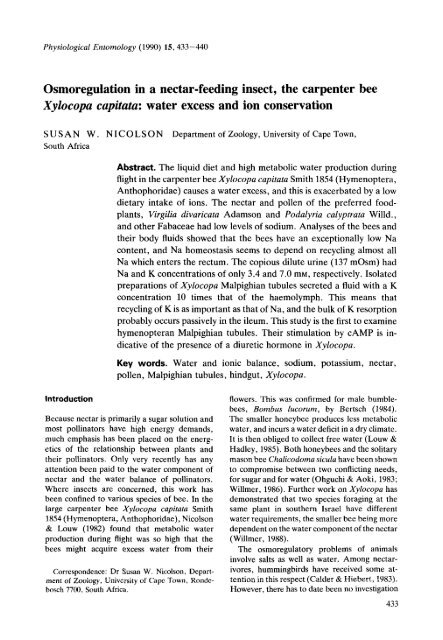
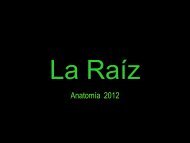
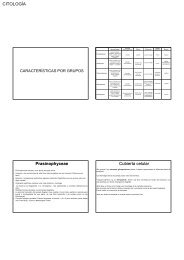


![Estructuras secretoras internas [4.64 MB]](https://img.yumpu.com/14294979/1/190x143/estructuras-secretoras-internas-464-mb.jpg?quality=85)
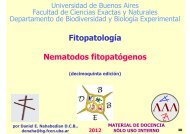
![anatomía y exomorfología [7.14 MB]](https://img.yumpu.com/12744163/1/190x143/anatomia-y-exomorfologia-714-mb.jpg?quality=85)
